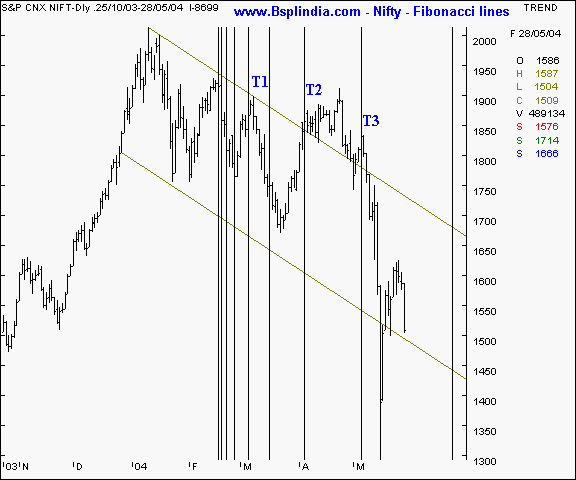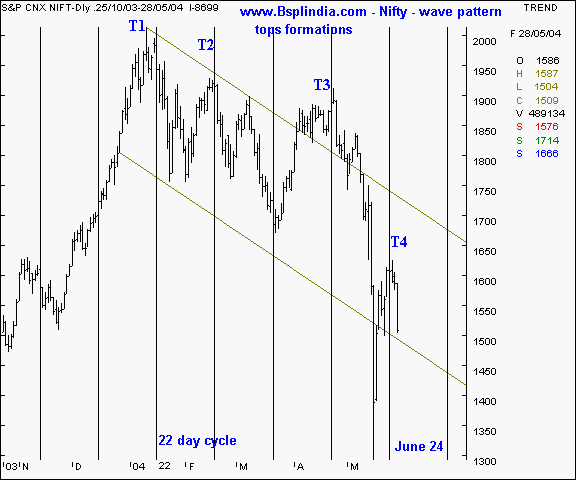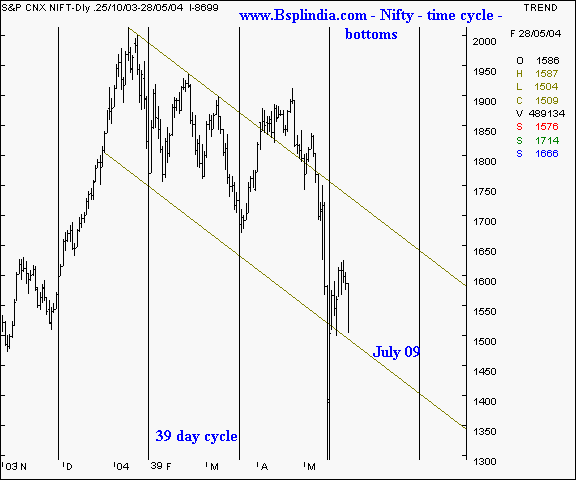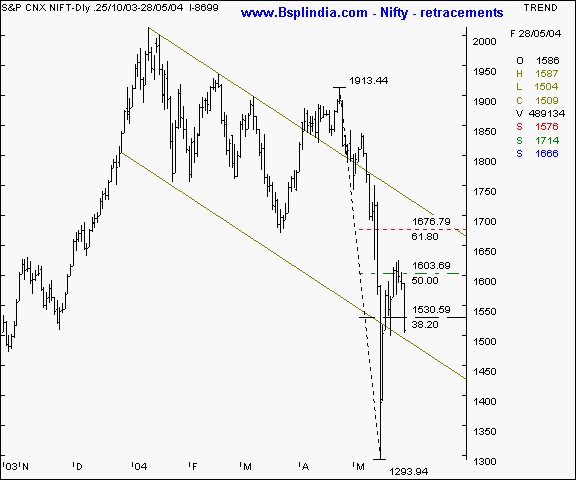- The Professional Ticker Reader TM
- Your accurate, authentic and affordable guide to investing
- April 21, 2009
Friends, in the last few weeks, we have been following a wait & watch approach which has been bordering on the near absence of intra-day trading and routine trading styles. We were waiting for a sign of clear directional guidance and some hints as to what the external triggers ( political, policy issues and international events ) would be like. The markets are completely news driven and shallow and therefore call for abundant caution. The process of wealth creation also includes great adaptability, innovation in technique and abstinence from the impulse to trade frequently during turbulent times. Extreme caution is called for - and we layout a broader gameplan for the benefit of our investors.
The changed scenario - the NDA is out, and the UPA is in. The left parties are an important component of the alliance and will keep flexing their muscles at intermittent intervals. The coalition ride promises to be bumpy and the stock markets are unlikely to be an insulated entity. Every ripple in the centre will cause a tidal wave in the markets. There are reversals in the offing in the political thinking and will cause a major reshuffle in the market valuations. The exit polls resulted in shedding of the flab, the vote count accelerated the fall and the govt constitution iced the cake. We don't think the investing / trading fraternity has completely factored in the changed mindset, and therefore, further falls are in the offing. As disappointment rises, falls will result and the process will continue for now. Stocks are in weak hands as of now. The market dynamics are pointing towards some systemic weakness that will need to be rectified before upmoves can be seen again.
The external factors - this area is the most under-rated of all triggers and need to be factored in fully to prepare for what lies ahead. The points of inflection are really three fold - a) Oil prices, b) FII inflows & c) US interest rates. We take them one at a time.
-
a) Oil has been the bone of contention since the prices escalated above the US $ 34 per barrel. Global economic recovery depends on it and will decide the international stock market performance. India cannot perform in isolation, after all, two thirds of our import bill is towards crude payments. Our self sufficiency in oil is light years away and presently on paper only. Higher import bill will escalate inflation, drive up input costs for corporates, electricity and cost of living for citizens. Industrial growth and profitability will take a hit. The OPEC meet in the early part of June will determine the immediate pricing which has eased off the $ 41.70 per barrel highs, but a drastic output hike is needed to ease the overheated prices. A production hike by saudi arabia is underway ( saudis produce one third of the OPEC output ), but all OPEC countries are already pumping at near full capacity and the absence of full scale production from Iraq is sorely missed. It will be almost 2-3 years before Iraqi output reaches peak levels. While we do not intend to play the devils advocate, it maybe remembered how the US stock markets reacted in the 1970's in the period called the "oil shock". Rising crude prices have a ability to cause a huge slip in the markets. The implications for domestic sectors is analysed seperately.
-
b) FII inflows are in a negative spiral since the last month or more. They are sellers to the extent of Rs 3,500 crs approximately and our market intelligence suggests a further paring of exposure to Asian equities. The rally in the Indian equities markets was caused by FII buying to a large extent. Their bullishness brought in the retail and domestic institutional players. Their exit is likely to unnerve a lot of players. There is a misconception in a large number of people that FII's will not / cannot sell a major portion of their holdings due to the huge losses that will risk incurring in the bargain. We beg to differ !!. Please bear in mind that allocations to India are between 3.5 - 5 % of their global assets and taking a 30 - 40 % losses on their investment will mean less than 2 % loss on their global float. This extent of a loss is easily absorbed by institutional players. Though this scenario is extreme, it must be understood and kept in mind for a better understanding of why these players are selling relentlessly.
-
c) US interest rates are another joker in the pack which many retail investors have yet to understand and therefore compute in their overall gameplan. The hedge funds are short term players. Period. They exploit arbitrage opportunities wherever possible. So far, the India story was positive. The Rupee was gaining against the US $, stocks were rising and corporate profits were zooming. The NDA was expected to return to power and continue the reform / disinvestment process. The hedge funds borrowed at cheaper rates in the US, invested in India and made double profits - stocks were zooming and their investment in Rupees were gaining against US $. There was capital gain and treasury gain in currency. Now the US $ is on the rise and stocks in India are falling, the NDA is gone, left parties are in. Besides, if the Fed raises the interest rates, the hedge funds pay higher charges. Expect hot money to flow out - as it has been seeing a flight outwards.
Introduction | CMP & its impact | Technical projections | Your strategy | Top
The UPA has been greeted by the markets with more than a sense of caution. We have had statements by left party leaders deriding stock markets as havens for slush money, un-important financial institutions and non-priority areas. These statements have left many a player dazed by the prospect of huge losses. The worst nightmares of the investors have been triggered ( whether they are justified or not is a function of time ) and selling has emerged. The CMP ( common minimum programme ) has been greeted very negatively indeed and the Sensex dived 223 points on Friday. Though the FM tried to calm frayed nerves, worries remain. Our basic understanding of the market worries ( as compared to the UPA's intentions ) - from the point of investors are a few moot points as below -
-
Electricity bill review - the reform process in the electricity sector cannot be emphasised enough. We operate from Mumbai - the commercial capital of the country. Our office area suffers power cuts infrequently, but sort of expectedly every summer and monsoon ( hope our clients understand our difficulties better now
 ). The country remains a power deficit tiger in the making. Yet there
is a sense of unreal reality, there are controls and restrictions by
the powers that be, that decide the private sectors expansive aims.
While the social aspect of cheaper pricing are important, they make
many a plan unviable at the inception stage itself. The latest salvo
is the curb on T&D ( transmission and distribution ) activities of
the private power companies. Is it not an open secret that theft of
power takes place at the distribution stage itself ? The losses
incurred by the generating companies are huge in magnitude. The second
aspect is the staggering discount to the farmers on power supplies.
This subsidisation is likely to hit the non-agricultural consumers and
the generating companies alike. The sheen is clearly off these shares
like Tata Power, Reliance Energy ( BSES ), CESC and others. Mumbaities
will recollect how Bhiwandi ( a small township 45 kms away from the
city ) stole the thunder from organised textile giants like Grasim,
Raymonds and Dinesh mills due to the sheer theft of power for their
looms, thanks to the complicity of the govt officials. We fear large
scale theft if distribution is left to the govt agencies. The FII's
are unlikely to swallow the cheap power to farmers scheme favorably.
Expect sustained pressure on these stocks.
). The country remains a power deficit tiger in the making. Yet there
is a sense of unreal reality, there are controls and restrictions by
the powers that be, that decide the private sectors expansive aims.
While the social aspect of cheaper pricing are important, they make
many a plan unviable at the inception stage itself. The latest salvo
is the curb on T&D ( transmission and distribution ) activities of
the private power companies. Is it not an open secret that theft of
power takes place at the distribution stage itself ? The losses
incurred by the generating companies are huge in magnitude. The second
aspect is the staggering discount to the farmers on power supplies.
This subsidisation is likely to hit the non-agricultural consumers and
the generating companies alike. The sheen is clearly off these shares
like Tata Power, Reliance Energy ( BSES ), CESC and others. Mumbaities
will recollect how Bhiwandi ( a small township 45 kms away from the
city ) stole the thunder from organised textile giants like Grasim,
Raymonds and Dinesh mills due to the sheer theft of power for their
looms, thanks to the complicity of the govt officials. We fear large
scale theft if distribution is left to the govt agencies. The FII's
are unlikely to swallow the cheap power to farmers scheme favorably.
Expect sustained pressure on these stocks. -
The rural credit drive - cheap loans to farmers is a commendable idea. But the thrust on the banking sector to double the credit to farmers and that too with subsidised interest rates will impact the banking sector hard. There will be higher NPA's and interest income will be disproportionate to the higher deposit rates. Since we expect the interest rates to go up, deposit rates may see a rally too, in which case the chasm between cost of borrowing and the rate of lending to agri sector will widen. There is also the element of reading between the lines of the school of thought that urban consumers avail of cheaper car finance rates, whereas the farmers pay a higher interest rate for tractors & farming equipment. Though the basic argument is valid, it does not take into account the higher risk profile of a farmer / borrower, as against the urban consumer who has tax papers and credit worthiness. We feel urban interest rates on automobiles, consumer goods and allied services to go up. Markets have taken this move negatively.
-
Disinvestment agenda - the CMP talks about the retention of all profitable PSU's and hiving off of the loss making PSU's. The profit making PSU's will be allowed to raise working capital funds from the primary market route. We feel this argument is full of weakness. Firstly, the definition of a profitable PSU is not defined. Is a PSU generating Rs 10 crore profit on an investment of Rs 1,000 crs profitable ? Secondly who will buy the loss making PSU's unless it is accompanied by a juicy carrot elsewhere ? Thirdly, if the government intends to retail a tight control on the management say in running the PSU's, who will subscribe to their IPO's ? True, the dividend yield will be fair, but such opportunities are available in the markets, that too with chances of decent capital appreciation. Expect a de-rating of the PSU sector shares.
-
Petro product prices - this will be a first test of the political will of this alliance government. The import parity price is significantly higher than the domestic selling price. This means a loss for the canalising companies like ONGC and to a degree, IOC. The left does not want high oil prices, and advocates a hike of no more than 1.50 - 2 Rs. That will bleed ONGC and the likes, unless international prices drop significantly. The deferring of the hike to June 15 has therefore actually seen a drop in share prices, even though it is deflationary. Knowledgeable FII investors understand that the state cannot lose money due to cheaper oil prices to keep the vote banks happy. If the oil price hike is not implemented on June 15, expect a deepening crisis in the markets. Be sure that this loss in oil will be made good by the government by raising revenues from the public in other ways.
-
The automobile initiative - the impact of interest rates on auto finance is already covered previously. The automobile sector is likely to be hit from multiple angles. Higher interest cost, higher petro prices, high steel prices and other levies. Our investors will recollect the CMP proposal to protect the poor Indian farmer from cheaper imports like edible oils and rubber. High domestic costs of rubber will result in higher tyre prices. Also observe how the NCR ( national capital region - Delhi ) has announced a hike of 2 % in RTO registration charges w.e.f. Aug 01, 2004. Higher bracket luxury cars will attract a 4 % hike in registration costs. Should this be widespread ( with the left parties, it maybe so ), cars will become significantly more expensive. Profitability of the auto companies will be under pressure as the business becomes commoditised. The crashing share prices of Telco & Maruti are a case in point. We feel that Maruti will have a bigger market share as it has a stronger presence in the small car segment which may not see a big demand shrinkage.
These are some of the worries that we have listed out for our investors on a need-to-know basis. We feel presenting the picture will empower you to take a balanced view of the market.
Introduction | CMP & its impact | Technical projections | Your strategy | Top
The markets are in a highly volatile stage and no analytical tool will guarantee significantly accurate results. We can, however, get approximate ideas on the levels of the indices, turning points, estimated time of turning points and significant tops and bottoms with their time frames involved. We try to use these analytical tools below to get a handle on these clues -
What is the short term outlook for the market now ?
The fibonacci lines plotted on the daily bar chart of the Nifty shows a fairly accurate measurement of significant highs since January 2004. The three previous tops were forecast with a fair degree of accuracy and we expect the markets to see significant activity in the third week of June 2004, which will see a new significant high or low. The new low can test the May 17, 2004 lows of 1300 - 1340 levels. The fall on May 17, 2004 ( black Monday ) has been out of sync with all parameters and therefore creates an uncertain outlook in the near term. It should be noted that the week between June 18 - 24 is a crucial one for the markets as the indices are likely to attempt a rally in the run up to the budget. This coincides with the Fibonacci lines and strengthens our view that this period will be marked with very high volatility.

When will the market peak out ?
The markets have an uncanny pattern of cycles which are analysed below. Note how every 22 days, a new peak was made. Barring the mid March 2004 when the markets went down on election considerations. Note how the top marked as T4 has seen a fall towards the bottom trendline of the bearish channel. It is highly likely that this channel bottom be violated and the Nifty test the 1400 - 1450 levels in the near term. The projected time frame is upto June 24, 2004. The markets are likely to remain subdued with selling on advances till then. Traded volumes must be noted on every rally. If the volumes are lower on rallies and higher on falls, expect a big fall on any adverse news. The markets are very shallow as of now and a small bit of buying or selling will be sufficient to cause significant moves.

When will the market bottom out ?
The time cycle study of computing bottoms shows that there is a new bottom made every 39 trading days. Please note how this pattern has been accurate since November 2003. Using this pattern, we arrive at a rough and ready date of July 09, 2004. The markets should see a bottom on or around this date. Again traded volumes need to be noted on all significant moves for trend determination.

Where can the markets rally upto ?
The markets are also going to see upmoves in conjunction with the falls. Though the falls are likely to be more pronounced, the pullbacks are equally likely as the shallow markets and low open interest means small to medium scale buying will see upmoves. However, the upmove will be restrained as upsides will see selling by nervous bulls. There are a few considerations to be remembered, the 200 SMA is at the 1650 levels and is a formidable resistance. The recent fall from the 1913 levels to the 1294 levels will see a pullback of 50 % to the 1605 levels, beyond which a minor chance upto the 1660 levels exists. However, prudence demands that shorts be initiated at 1600 and above on June futures with room for averaging upwards. Any sustained closing below the 1490 levels will see an accelerated fall.

Introduction | CMP & its impact | Technical projections | Your strategy | Top
Since the immediate outlook is sideways to bearish, we suggest abstinence from an aggressive and high risk approach. True, the FM will attempt to talk the markets higher, but the reality checks are likely to remain. Therefore selling at higher levels is advocated, that too in small quantities. Writing call options at out of money (OTM) strike prices would be the ideal strategy going forward. Since the implied volatility is high, the premia available is attractive indeed. The marriage of technicals and F&O studies will be used to achieve superior returns. Since we know the sectors that are likely to remain under pressure, we write options on those counters itself. We will be updating this table via daily newsletters and supplement these recommendations with futures trades via sms / yahoo messenger realtime reco's.
| Scrip | Reco | Outlook | Entry | Stop-loss | Target | Market lot | Margins |
| Hind Lever Jun 160 calls | Sell | Expiry | Premium 1.25 | 2.50 | Expiry | 2000 | 55,000 |
| HPCL Jun 400 calls | Sell | Expiry | Premium 2.50 | 5 | Expiry | 650 | 45,000 |
| IPCL Jun 190 calls | Sell | Expiry | Premium 1.10 | 2.50 | Expiry | 1100 | 57,000 |
| Maruti 520 Jun calls | Sell | Expiry | Premium 2.50 | 5 | Expiry | 400 | 47,000 |
| MTNL 150 Jun calls | Sell | Expiry | Premium 0.85 | 1.50 | Expiry | 1600 | 48,000 |
| SBI Jun 600 calls | Sell | Expiry | Premium 3.50 | 7 | Expiry | 500 | 67,000 |
| SCI Jun 110 calls | Sell | Expiry | Premium 2 | 4 | Expiry | 1600 | 70,000 |
| Synd bank Jun 50 calls | Sell | Expiry | Premium 0.35 | 1 | Expiry | 7600 | 85,000 |
| Synd bank Jun 45 calls | Sell | Expiry | Premium 0.60 | 1.20 | Expiry | 7600 | 1,00,000 |
| Telco Jun 500 calls | Sell | Expiry | Premium 1.50 | 3 | Expiry | 825 | 90,000 |
| Telco Jun 480 calls | Sell | Expiry | Premium 2.50 | 5 | Expiry | 825 | 1,00,000 |
| Tata Power Jun 360 calls | Sell | Expiry | Premium 2.25 | 5 | Expiry | 800 | 60,000 |
| Tisco Jun 400 calls | Sell | Expiry | Premium 2 | 4 | Expiry | 900 | 60,000 |
| Union Bank Jun 70 calls | Sell | Expiry | Premium 0.55 | 1.25 | Expiry | 4200 | 90,000 |
| Union Bank Jun 65 calls | Sell | Expiry | Premium 1.50 | 3 | Expiry | 4200 | 1,10,000 |
| Nifty Jun 1740 calls | Sell | Expiry | Premium 6 | 12 | Expiry | 200 | 60,000 |
Introduction | CMP & its impact | Technical projections | Your strategy | Top
|
Trading tips for the week |
-
The put / call ratio is currently at the 0.21 : 1 levels and the outstanding positions in the derivatives segment have shown a qualitative & quantitative degeneration. The FII investments are continuing to be negative. Since the markets lack depth, we advocate absolute caution.
-
There is offloading at higher levels in stock futures. That indicates a cautious approach as long positions in individual stocks is being hedged by Nifty shorts. That is a major reason for the steep discount on the futures as compared to cash prices.
-
The index heavy-weights are showing weakness again. This in turn will drag the indices and cause nervousness in the undertone.
-
Oil prices remain our prime concern and need to be watched closely.
-
Trades must be executed in small volumes due to the higher volatility expected. Trade fewer counters and conserve cash for future opportunities.
-
Standby for fresh recommendations via SMS on a real - time basis.
- Have a profitable week.
- Vijay L Bhambwani
- Ceo :- Bsplindia.com
The author is a Mumbai based investment consultant and invites feedback at Vijay@BSPLindia.com and ( 022 ) 23438482 / 23400345.
SEBI disclosure :- The author has no positions in any securities mentioned above.
- While all due care has been taken while in compiling the data enclosed herein, we cannot be held responsible for errors, if any, creeping in. Please consult an independent qualified investment advisor before taking investment decisions. This mail is not sent unsolicited, and only advisory in nature. We have accepted no consideration from any company mentioned above and recommend taking decisions on merits of the stocks from our viewpoint. This email is being sent to you as a paid subscriber. Please protect your interests and ours by not disclosing the contents to any un-authorised person/s
Legal notice :- The Professional Ticker Reader is a trademark of Bhambwani Securities (P) Ltd. and any un-authorised replication / duplication in part or full will be infringing our trademark and will result in legal action being enforced on the infringing persons / parties.